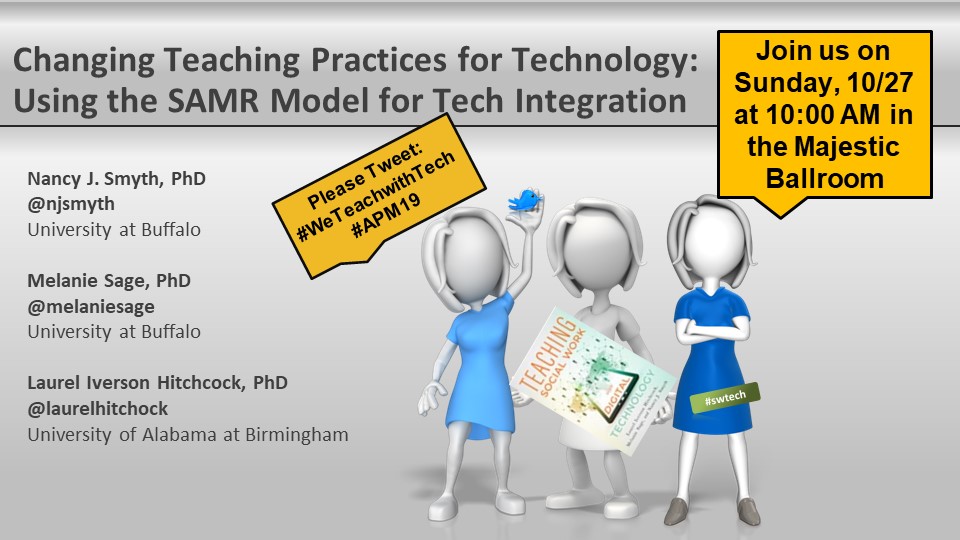#APM19 – Changing Teaching Practices for Technology: Using the SAMR Model for Technology Integration

On October 27, 2019 at 10:00 AM, during the Annual Program Meeting for the Council on Social Work Education in Denver CO, Melanie Sage and I will be sharing some insights from Chapter 4 of our book, Teaching Social Work with Digital Technology, co-written with Nancy Smyth. If you are still in Denver, please come find us in the Majestic Ballroom –Tower Building of the conference hotel. We will be sharing how Puentedura’s SAMR Model for Technology Integration can be used to incorporate technology into traditional social justice assignments in social work education. There will also be time to adopt one of your current assignments using the SMAR Model.

Additionally, we’ll be talking about our virtual book group that will be launch in January 2020. You can read more about it here:
For those of you who cannot make the presentation, we are including the details in this blog post.
#APM19 The Flip(grid) Classroom: Utilizing the Microsoft app Flipgrid to promote student learning

Editor’s Note: In this blog post, I have asked four colleagues from the University at Buffalo School of Social Work to share some information about their presentation at the 65th Annual Program Meeting for Council on Social Work Education next week in Denver, CO. Katie McClain-Meeder, Michael Lynch, Todd Sage, and Margie Quartley will share about their experiences using Flipgrid, a video-based discussion forum, in the social work classroom. In full disclosure, they did ask me to record a video for their presentation, so I may be making a guest appearance during the presentation. Also, you might be interested in reading Todd’s previous blog post about FlipGrid – Incorporating Flipgrid into the Social Work Classroom: Tips for #SocWorkEd.
On October 26, 2019 at 10:30 AM, we (Katie MaClain-Meeder, Michael Lynch, Todd Sage and Margie Quartley from the University at Buffalo School of Social Work) will be presenting an interactive workshop titled The Flip(grid) Classroom: Utilizing the Microsoft app Flipgrid to promote student learning, at the Council on Social Work Education’s Annual Program Meeting. We will be in the Governor’s Square 11 in the Plaza Building.
We know that students are increasingly expecting instructors to utilize new technology to enhance instruction beyond the traditional classroom lecture and content. It is imperative that instructors find meaningful and relevant opportunities to integrate tech into the classroom. Our interactive workshop will introduce you to the video discussion app Flipgrid, which allows students and instructors to quickly and easily interact using short video responses that can be captured via computer or mobile technology. We will highlight case examples, including use for field education, new student orientation, and ways to add depth and breadth to in-person and online instruction.
By attending our workshop, you will learn best practices for introducing and structuring Flipgrid for a variety of educational purposes as well as how to manage Flipgrid from the administrative side, including how to grade, respond and manage discussions. The workshop will also culminate with an opportunity for you to set up their own “grid” with support from us, the workshop instructors.
Conference Presentation: Developing a Professional & Ethical Online Presence for Social Work Practice
On Thursday, October 3rd, I will be at the Alabama/Mississippi Social Work Education Conference presenting with Allison Curington, Field Director at the University of Alabama, about best practices for social workers in the use of social and digital media when working with clients and communities. During this workshop, we will cover the basics of social and digital technologies as well lessons learned from experience with training students and social work practitioners. Additionally, we will be sharing how to access the Social Media Toolkit for Field Educators, a free resource with educator’s guide and a PowerPoint slide deck.
If you won’t be at the conference, I am including all the important details about the presentation in this blog post.
First, you can access your own free copy of the Social Media Toolkit for Field
Educators here:
https://laureliversonhitchcock.org/2018/11/05/revised-social-media-toolkit/
Second, here is a link to a worksheet from the presentation: Develop your Professional Social Media Policy Worksheet
Teaching Social Work with Digital Technology Book Group

If you teach social work with technology, either online or in a traditional classroom, we (Melanie, Nancy and Laurel) invite you to learn with and from peers in this free book group – Teaching Social Work with Digital Technology. Goals of this virtual book group are to: 1) create a supportive learning community; and 2) provide space for reflection about one’s own professional development with teaching with technology.
This group will run from January to June 2020, with monthly meetings and a moderated online private Facebook group. The group will include live virtual meetings, with discussion moderated by an author and a guest educator. In between meetings, social work educators will lead and moderate book discussions, and offer reflective questions and simple learning tasks. Participants should have access to the book by January 2020. The schedule follows:


